|
|
|
sailing out of Puerto Ayora
Tuesday, January 25 2005
setting: Quito, Ecuador
Today was the day we would be beginning the Galapagos leg of our Ecuador experience. Before sunrise we were awakened by the surly hostal staff because our ride to the airport had arrived. Our driver was a young woman who spoke perfect English but was perfectly happy to speak in Spanish when Gretchen responded in that language. She proceeded to give us the itinerary in a rather long-winded fairly rapid-fire delivery, interspersed occasionally with our saying "si." I didn't really comprehend much of what she was saying.
Though the Galapagos are part of Ecuador, from the airport procedure you'd think we were flying to a completely different country. Our bags were inspected and we had to show our passports on both ends of the flight, though the Galapagos inspection was mostly to keep out the introduction of exotic species.
In the airport waiting room I did as I always do when I have a laptop and need to kill time. I flipped it open and searched for an open wireless access point. There was one, but it was encrypted. At first I thought all was lost, but then another one called PLANMAN appeared and it was completely open! Unfortunately, it was very unreliable and seemed to come and go like the wind. We tried different parts of the waiting room to see where it was most powerful, but it seemed to be about equally bad everywhere. Given its name, I had the feeling that it hadn't been intended as a public access point.
Gretchen somehow managed to receive her emails and send all the responses that needed to go out, including a real-time dialogue with our house sitters about how to actually get the DVD player to work.
Ecuador's interior airline is called TAME, and the plane we boarded was an Airbus every bit as modern as a plane flying similar missions in the United States. Along with us on our flight was a school group consisting of a dozen pre-teen boys. Gretchen and I had arranged to sit near the window in adjacent rows, and one of these school boys was seated beside me. His pals in front of us leaned over the seat, sized me up, and jokingly cautioned their friend, "Te cuida" (take care). Later the third seat in our row was taken by the woman in charge of the schoolboys. She must have been unmarried, because the boys kept calling her se&ntild;orita. For her part, she kept having to shout at the boys to ensure they behaved. "Santiago! Sientase!" That sort of thing. When American tourists boarded the plane (mostly in Guayaquil), they all shouted "Hello!" to demonstrate their English skills. More impressive was when one of the lads translated the se&ntild;orita's orders into English for the hell of it.
The flight out of Quito was much more spectacular than even last night's landing. The clouds had mostly lifted and sun was out, so we had a clear view not just of the high ridges on either side of Quito, but also of the obscenely tall Andean volcanos in the distance. They put the peaks of the Rockies to shame with their permanent coating of ice clinging to most of what could be seen poking above nearer, more modest mountains. Remember, this is within a few miles of the Equator (which passes just north of Quito). Impressive in its own way was a lesser peak just south of Quito whose top 50 feet appeared to have been freshly dusted with snow.
Not far from or below this lesser peak we could see evidence of high-elevation agriculture, mostly in the form of Alpine-style pastures. Further from Quito there were occasional patches of forest on the uplands, but these were never especially vast. Without exception, all of the lowlands to the west were being intensively cultivated. Many of the fields were brown, indicating they'd either just been planted or harvested. In tropical climates, either could be happening at once depending on the crop.
For some reason all flights to the Galapagos actually leave from Guayaquil, so soon enough we were back in that coastal city. Again the vacuum cleaner crew passed through and then we took on new passengers, nearly all of whom looked to be gringo tourists.
The part of the flight that occurred entirely over water lasted about two hours. All that featureless ocean garnished with regularly-spaced clouds provided me a clear demonstration of the remoteness of our destination.
The airstrip where we landed was so small that it ended with a cul de sac where the plane turned around and drove back to the airport using the same tarmac it had touched down upon.
The main Galapagos airport is on the small island of Baltra, just north of the most populated (by humans) island of Santa Cruz. As we climbed out of the airplane, we were greeted by a pleasant blast of hot dry air. Gretchen made the observation that it was like the kind of air you first encounter after landing in Isræl.
In the airport, special inspectors went through our luggage to make sure we weren't importing exotics such as cats, dandylions, or weasels to the planet's most famous evolutionary laboratory. Next we each had to pay a $100 fee charged to every non-Ecuadorian visitor to the Galapagos.
Then we waited around for things to happen in the tiny airport's busy arrival area, which was completely open to the air but protected by a roof. (The protection it offered was more against the sun than the unlikely chance of rain.) Many of our clothes were still wet from the drenching they'd received last night in Quito, so we spread them out and hoped they'd dry in the dry desert island air.
Most of the others in the arrival area were Americans, and most of those were older people, the kind of American who can afford to travel. Many of these people would be sailing on a big, comfortable tour boat. For us, though, a scrappy little yatch named the Golondrina would have to do. Gretchen had booked us a cruise in a class she described as "top of the bottom" (not to be confused with bottom of the top or bop of the tottom).
The representative for our tour put us together with a group of others who would be sailing on the Golondrina (and its sister ship, the Fragata) and proceeded to shepherd us through several forms of transportation, never giving us any indication of the overall picture. First there was a bus from the airport to a ferry, then a ferry ride across the narrow strait to Santa Cruz island, and then a long bus ride across the island, one of the largest in the Galapagos.
Starting on the north side of Santa Cruz, the scrubby cactus-rich vegetation suggested a desert. But near the top of a volcanic ridge (and past what looked like a massive crater), the vegetation changed dramatically, turning in a lush rainforest. This lushness continued for a ways down the south side of the mountain past a small town. Our bus ride ended at a transportation hub just outside Puerto Ayora, the largest town in the Galapagos. From here, extended-cab pickups called "taxis" carried us to the docks of Puerto Ayora. By now we'd met several of our fellow passengers on the Golondrina. There was a young couple from France (he could speak English and she could speak Spanish). There was also a young couple from Japan, but they would be sailing on our sister ship the Fragata (a fancier boat whose passengers largely consisted of older folks from the United States).
Already in the Puerto Ayora harbor we could see the characteristic (and vaguely creepy) wildlife of the Galapagos. Here was a pair of bright red scuttling Sally Lightfoot Crabs. There, lazily avoiding the taxis in the harbor cul de sac, was a big black marine iguana. We were already snapping pictures.
Before long we were picked up by one of the Golondrina's dinghies (called "pangas" in Ecuador) and taken to the Golondrina out in the harbor. It was one of the few ships in the harbor with sail masts, though these weren't used for anything but antennæ sites.
The online literature about the Golondrina says that the cabins share two bathrooms, but in reality all the cabins have their own bathrooms, each with its own shower. Our cabin was number one. It was unfortunately close to the engine, but at least it wasn't in the process of being dismantled by termites, as some of the cabins in the middle of the boat were. There were six passenger cabins in all, each with a capacity of two. Elsewhere on the boat there were accomodations for six crewmen. The main indoor public space was the dining room near the center of the deck. Additionally, there were places for people to socialize at the front and back of the deck, behind the control room, and beneath a tarp one floor above the deck in the back.
While we were putting our stuff in our cabin, we heard an explosion of annoying girlish laughter in the hallway. Oh no, we wondered, was our eight days at sea going to be ruined by ugly Americans? In the end, though, it turned out that we were the only Americans on the boat. The loudest people with us were actually Australians (there were five of them and one of them had the worst sort of laugh). In addition to them, there were three young women from Sweden, a youngish German man, a woman from Scotland, and the two Frenchfolk. Our crewmen spoke little if any English, and even Cezar, our our supposedly bilingual guide, seemed happiest conversing in Spanish. Gretchen and he conversed in that language for a good while as we motored off to Santa Fe Island after a lunch of fried fish eaten, with, well Nescafé instant coffee. That's far and away the most common form that coffee takes in Ecuador, a cruel irony for a nation that shares a 200 mile border with Columbia. The coffee revolution has yet to sweep the land in which it is actually grown.
Though we could see it off in the distance, Santa Fe took two hours to reach at our boat's pokey pace of 8 knots. The sea was rough along the way and before long both Gretchen and I were feeling sea sick. It never got to the point where we needed to throw up, but it sure was nice when entered the wave-shadow of Santa Fe island and the waves settled down.
Eventually the Golondrina's anchor was dropped in a bay in Santa Fe's north coast and we were taken for our first adventure, snorkling along the shoreline of a tiny island in the mouth of the bay.
I'd never snorkled before and there were no lessons offered on how to use the equipment. Since I can barely swim to begin with, I was understandably reluctant to jump into the water. I couldn't see the bottom from where our panga was dropping us off, so I knew it was deep. When I finally found myself in the water, I frantically doggy-paddled for the island, a barren pile of black volcanic boulders accented with cactus trees.
This was to be our first real experience with the specialness of the Galapagos wildlife. Right there on the shore, not more than a meter or two away, were red crabs, black sea iguanas, brown pelicans, sea lions of all ages, and the creature Gretchen had mentioned most in anticipation of this trip: the Blue Footed Booby. It's a cross-eyed seabird with a big, conical bill and unnaturally blue feet. Beneath the water (once I figured out the basics of snorkling) I could see the water teeming with a great variety of colorful fish and other sealife. One didn't have to wait long before being accosted by a playful sea lion, some of which would gently body-check you as they swam past. The sea and shoreline was a thick, chunky stew of living things, and none of the creatures seemed to be the least bit afraid of human beings.
After I'd been sufficiently wowed by the wildlife, I turned my attention back the business of snorkling. My technique seemed to be all wrong and I had no idea how to cope with seawater on the occasions when it would find its way down the snorkle. Several times I inhaled saltwater and was sent madly paddling back to the rocks for safety and recovery. I was jealous of my fellow passengers on the Golondrina, all of whom snorkled without the slightest bit of difficulty.
I was such a snorkle loser that I had to retreat to the panga as the others swam (at the insistence of our guide) into deeper water between the tiny island and Santa Fe proper. There they were hoping to see sea turtles and sharks, though sealife there wasn't anywhere near as rich as on the shoreline.
Later we changed into hiking clothes and had a panga ride to the Santa Fe beach, where we spent a considerable time socalizing (and photographing) the sea lions as they sunned themselves. In terms of behavior, they acted like flippered dogs. Despite this, I somehow managed to convince Gretchen that they were actually fish, not mammals. (In truth, most scientist think that sea lions descended from bears, close relatives of dogs.)
On a short walk through the Santa Fe scrub we saw a Galapagos Hawk, several land iguanas, and smaller lava lizards. The biggest trees were all prickly pear cacti, though there were other, shrubbier trees as well.
Despite the fact that Gretchen had made abundantly clear months ago that she is a strict vegetarian and eats absolutely no fish, the guy serving our table at dinner responded to her "No como pescado" declaration much the way I might respond to someone claiming not to breathe air. "No pescado? Pero solamente pescado..." He'd never heard such a crazy dietary restriction in his life. In the end the cook fried her up a big disgusting omelette. This caused Gretchen to worry that maybe all her meals for the next seven days would consist of omelettes.
After dinner, we all assembled on the topmost level to hear Cezar give the itinerary for the next day. Somewhere in the course of this he and his fellow crewmates all dressed in their white uniforms and introduced themselves and served us weak piña coladas. Later the tarp was pulled back and we could see the dazzling stars of the equatorial sky. Unfortunately, though, a full moon poisoned the darkness.
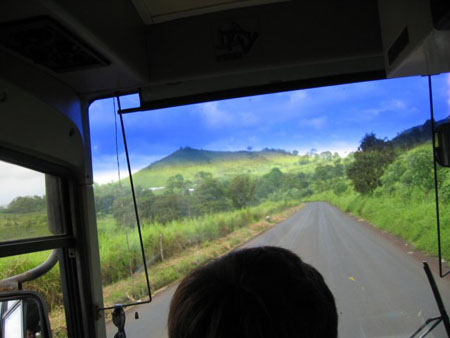
The lush vegetation south of the high point of Santa Cruz Island in the Galapagos.
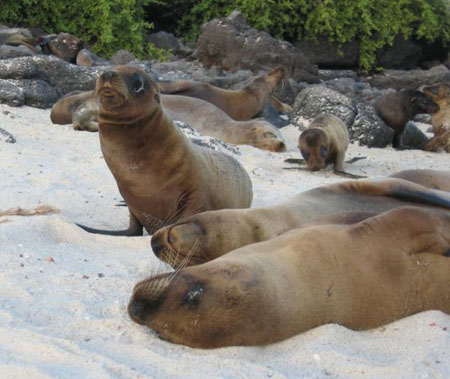
Sea lions on the beach of Santa Fe Island in the Galapagos.
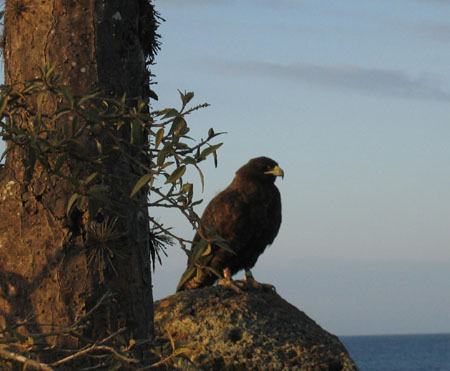
A Galapagos Hawk in a prickly pear tree on Santa Fe Island.
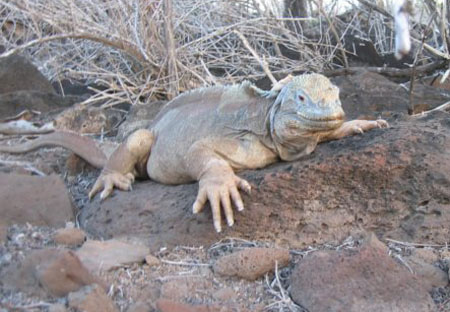
A land iguana.
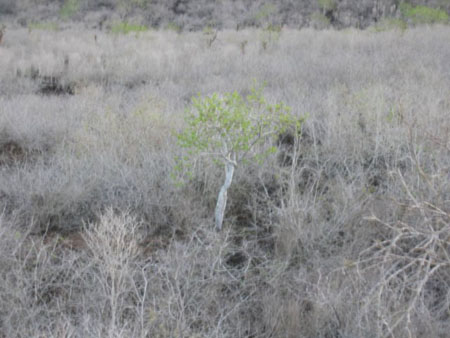
The scrubby Santa Fe vegetation.

Our crew in their uniforms. The guy in the chef's hat is named David and our guide is Cezar at the right end.
For linking purposes this article's URL is:
http://asecular.com/blog.php?050125 feedback
previous | next |





